Regional Inequality in Turkey
Regional Inequality in Turkey
Abstract
Our purpose in this paper is to analyze inequality of the regions not only over time but also examine inequalities both between and within regions. Since the prior researches recognize regional inequality as an important regional policy issue; hence, motivation to conduct the present research paper drives from the intent to re-examine the inequality findings provided by Gezici and Hewings (2004). The research strives to examine inter and intra regional disparities so as to answer the key question i.e. is Turkish inequality rooted in within regions or between regions?. Theil index provides clear indication for the increasing intraregional inequalities in Turkey while the pattern of interregional inequalities is declining. Interpretations of within and across region disparities on the basis of Theil index observations made during 2007-2011 are visibly different from those observed in the late 1990s. Findings of the research indicate Marmara and Central Anatolia regions as the key contributors to the growing disparities within and across regions in Turkey; in other words, the research results show that the poor regions relatively make little contribution to income inequalities than the developed ones. Therefore, the research identifies policy implications for considering the redistribution of national resources on the basis of interregional and intraregional dependence among the seven regions of Turkey.
Key Words: Regional inequality, Theil index, intraregional inequalities, interregional inequalities
Introduction
Regional inequality is not an interesting issue only for economists but also for sociologists as well. Regional inequality is measured by the differences in GDP per person across a country, which is an important indicator of a country’s economic welfare. This inequality is the evidence that a country’s GDP is not shared equally and justly among its population and that there needs to be some intervention in order to reallocate these sources.
In economics and social sciences, there has been a substantial literature about the relationship between regional inequality and economic and social factors where inequality is often perceived as an unpleasant economic condition. Inequality is often thought to lead to a slowing of economic growth because it demonstrates a lack in development and points to economic and structural inefficiencies. Besides its effect on growth, there has been a tentative consensus in the literature that inequality can undermine progress in health and education, cause investment-reducing political and economic instability, and undercut the social consensus required to adjust in the face of shocks (Berg and Ostry 2014). The effect of inequality on growth rates is especially heightened in democracies since it promotes distributional struggles (Weede 1997).
In the inequality literature, there is evidence of the persistence of a spatial dualism between east and west from the past until present in Turkey (Gezici and Hewings 2001). While the provinces located in the Southeastern and Eastern Anatolia areas are known to be lagging behind in economic and social terms, the provinces in the West like Istanbul are known as metropolitan cities. These geographical disparities can be traced since the period of the Ottoman Empire, when today’s metropolitan cities like Izmir and Istanbul were important trade centers. Since the ages of the empire, there has always been an inequality in terms of economic performance between East and West Antolia. However, with the foundation of the Turkish Republic industrial plans, infrastructure projects, and policies were implemented focusing on Central and Southeast Anatolia in order to lessen regional disparities and boost national growth (Celebioglu 2009). The focus of the policies wasn't only on the poor provinces; external oriented policies and the increased attention on European Union concentrated on the development of the metropolitan areas, creating advantage for them in a global context. However, the attempts to reduce regional disparities were gainless when the policies stimulated the economic activities both in developed and poorer regions (Gezici and Hewings 2003).
Motivations and Expectations
In the late 1990s and the early 2000, income inequality in Turkey has been the point of debate within the institutional and academic research houses. Numerous attempts have been made to study the nature and dimensions of regional inequalities prevailing in Turkey, for example, Balkir (1995) conducted a research to categorize the Turkish regional disparities into three segments that include economic disparities, infrastructural disparities and demographic disparities. On the contrary, Gezici and Hewings (2007) investigated regional inequalities in Turkey at three levels including geographical regions, coastal-interior and functional regions. Unlike the prior research studies, Gezici and Hewings (2004) adopted a unique approach i.e. Theil index to examine regional disparities at inter-provincial and inter-regional levels. Since the prior research recognizes regional inequality as an important regional policy issue; hence, motivation to conduct the present research paper drives from the intent to re-examine the inequality findings provided by Gezici and Hewings (2004). The research strives to examine inter and intra regional disparities so as to answer the key question i.e. is Turkish inequality rooted in within regions or between regions?
This research paper is expected to provide Theil index values on the provincial and regional basis so as to study the pattern of inequalities within and across the regions. The research paper extracts Gross Value Added (GVA) and population data on seven key regions of Turkey for the time frame of 2007-2011. Then, Theil index is followed to study the five years pattern of inequalities at intra-regional and inter-regional levels. These patterns of inequalities are expected to be compared with the trends observed by Gezici and Hewings (2004) and to provide evidence for consistent increase in the inter-regional inequalities and consistent decrease in the intra-regional inequalities, if any. In addition, the paper is expected to assist in determining the policy implications of inequalities within or between regions.
Methodology and Data
In the regional inequality literature, researchers use different classification methods to categorize the regions of a country. This classification mainly depends on how regions are defined and which classification method is the most suitable one for the research. Although some researchers prefer to use formal administrative units at the regional level to classify them, some countries like Colombia and Turkey have no formal units. Previous literature focusing on regional inequalities has categorized regions as geographical regions, functional regions, and coastal-interior provinces.
Our purpose in this paper is to analyze inequality of the regions not only over time but also examine inequalities both between and within regions. In literature, there are many studies on regional inequalities using both the Gini Coefficient and the Theil Index, focusing on the inequalities between regions. However, our methodology relies on Gezici and Hewings’ paper called “Spatial Analysis of Regional Inequalities in Turkey” that uses the Theil index to calculate both inter and intra- regional inequalities. Since, with this paper, our aim is to understand the dynamics and the role of regions and smaller units (province) on inequalities, it is not enough only to examine inter-regional inequalities. We should also find within regional inequalities to see the trends over time and the effect of within disparities on regional inequality of a country. This would enable us to compare whether inequality in countries roots from the disparities among or within regions. Gezici and Hewings’ methodology provides us with a Theil index that enables us to calculate inter and intra-regional inequalities. This Theil index is presented as the following equation:

Where; the first term measures intraregional inequalities while the second measures interregional inequalities. In this equation n is the number of departments or provinces in the second term and the number of regions in the first term. The first term is derived by multiplyingi , the GVA of each region proportional to the national GVA, times the log of i divided by xi, which is the population of each region proportional to the national population. The second term does the same calculation for all provinces in the country using provincial/departmental GVA with respect to national GVA as well as provincial/departmental population as a proportion of national population.
The values from the first and second terms are then used to examine what proportion of total inequality emerges between the regions and what proportion of inequality is coming from within the regions. We then look to analyze the changes in these proportions over time to understand some of the trends in inequality in Turkey.
Results
In Turkey, provinces act as administrative units; where the term’ region’ is only used to define the geographic division such as Aegean, Marmara and Eastern Anatolia, and to use economic development as a base to cluster different provinces. For example, Celebioglu and Dall’erba (2010) stand to the argument that Turkish provinces located in the Eastern Anatolia and Southeastern regions lack in terms of social and economic development. In this research paper, seven key regional areas are selected to be studied on the basis of GVA and population for a time span of 2007-2011. These seven regions include Aegean, Mediterranean, Black Sea, Central Anatolia, Eastern Anatolia, Southeastern Anatolia and Marmara regions.
Parameters for Analysis
GVA Basis
As can be seen in the graph below, Marmara region takes the lead at inter-provincial level with the highest size of GVA contributions. During the selected time period, estimates show consistent share of Marmara region to the overall GVA of Turkey, for example, the evaluation shows that Marmara region contributed average 44.72% of the total GVA of the country. The highest GVA contribution of Marmara region i.e. 45.31% was recorded during 2008 while the lowest contribution i.e. 43.98% was recorded during 2010.
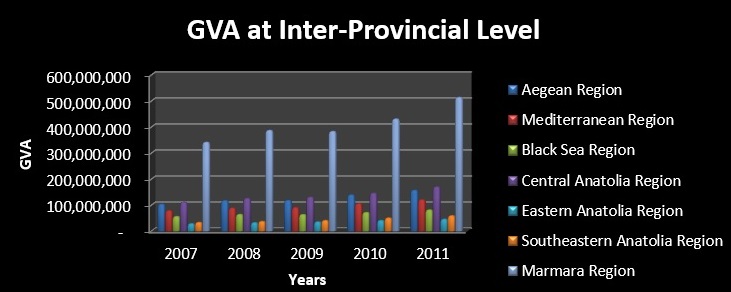
Graph 1: GVA at Inter-Provincial Level
The graph above shows that Marmara region is followed by Central Anatolia and Aegean regions in terms of GVA contributions. Interpretation of results shows that in 2007, Central Anatolia contributed 14.72% of the total GVA of Turkey; in contrast, Aegean region accounted for 13.75% of the total GVA of the country. On average, Central Anatolia makes up 14.86% relative to Aegean’s 13.82% contribution to the total GVA of Turkey. On GVA comparison basis, Eastern Anatolia makes the lowest contribution to the total GVA; hence, this region is expected to make the highest contribution to potential inequalities across the region.
Population Basis
On the population basis, Marmara is a highly populated region of Turkey with average population size of 22,899,013. During the given time frame, the region only reported 1.56% average growth in the population size. After Marmara, Central Anatolia ranks second with average population of 10,710,328; during 2007-2011, only 1.36% growth is recorded in the population size of this region. The graph below illustrates nearly consistent pattern of population chances across the seven Turkish regions during 2007-2011.
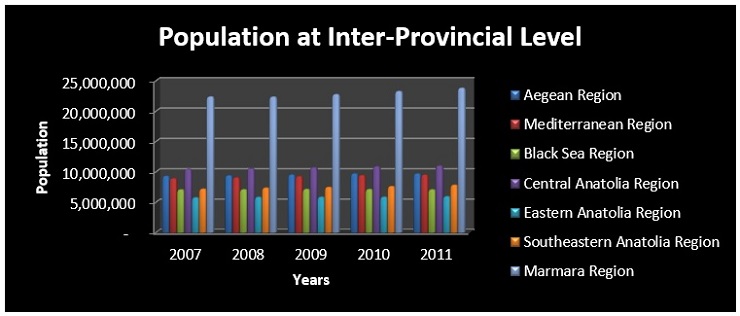
Graph 2: Population at Inter-Provincial Level
In comparison with the total country population, results show that Marmara region accounts for 31.53% of total Turkish population size; whereas on average, Central Anatolia makes up 14.75% of the total country population.
Inequality Results
Inequality at Inter-Provincial Level
The table below provides Theil index values for all seven regions across the selected time frame with positive and negative values depicting increase or decrease in the inequality levels as a ratio of income distribution to population. According to the data analysis, inequality within Aegean region has gradually increased over the given time frame; however, the average Theil index value for Aegean region is -0.00543 which means that the overall trend of inequality is downward. With an average Theil index value of -0.000777 and -000650; inequalities within Mediterranean and Black Sea regions have been declining over the years, respectively.

Table 1: Theil Index Values at Provincial Level
Data evaluation also suggests that disparities within the region are positively contributed by the increasing Theil index values of Central Anatolia and Marmara regions. According to the statistics, 109.55% of the average five years inequalities at inter-provincial levels are contributed by Marmara region while Central Anatolia region was accounted for 1.68% average increase in the intra-provincial disparities. In addition, the analysis shows that inequalities within the region has increased during 2007 and 2008, but later on, the inequality pattern turned downward through the three consecutive years. In agreement with Gezici and Hewings (2004), the research results indicate relatively low within the region inequalities contributed by Eastern Anatolia, Mediterranean Sea, Black Sea and Southeastern Anatolia regions. Similar to the patterns observed in the 1990s, results indicate three main contributors of inequalities within the region. As it is evident from the statistics shown in the table above, Marmara region is takes the lead in causing inter-provincial or within the region inequalities. Analysis shows that the region accounts for the highest share of within the region inequalities. Moreover, Central Anatolia and Aegean regions also make higher inequality contributions to the observed patterns of disparities within the region.
Corresponding to the research findings presented by Gezici and Hewings (2004), the research results indicate that the largest inequality share of Marmara region is highly contributed by the growing inequalities within Istanbul. On average, results indicate 0.0224 term value for Istanbul relative to 0.0037 of Bursa, 0.0013 of Edirne and 0.0039 of Bolu. Similarly, inequalities within the region of Central Anatolia are significantly shared by Ankara with the term value of 0.0016. On a simple note, interpretations of data results indicate that Marmara and Central Anatolia with Istanbul and Ankara are the highest contributors of inequalities within the region and within the provinces.
Inequality at Inter-Regional Level
During 2007-2011, the highest interregional inequality value i.e. 0.0296 was observed in 2008. In this year, 10% of the total interregional disparity was shared by Aegean region while 247% of this inequality value was observed as the share of Marmara region and 6% was the share of Central Anatolia region; whereas, the negative Theil index values of the remaining four regions i.e. Mediterranean, Black Sea, Eastern Anatolia and Southeastern Anatolia regions depict negative percentage share of each of these regions to the total interregional inequalities.
Unlike the intra-provincial inequalities, the results depict slightly different patterns of inequality contributions at inter-regional levels. Theil index values quoted in the table below reflect the yearly inequality share of each of the seven regions from 2007 to 2011. During 2007, 9.82% of the total 0.026 regional disparity value was contributed by Aegean region and this share has been consistently increasing over the next three years; however, in 2011, Aegean’s share of across region inequality decreased from 19% (2010) to 13% (2011).
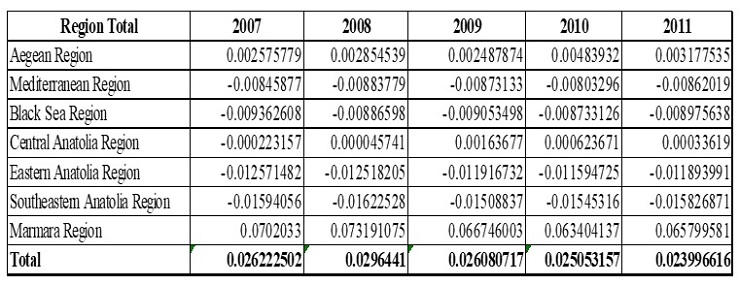
Table 2: Theil Index Values at Regional Level
Data results indicate stable and relatively minimal contribution of Mediterranean Sea and Black Sea areas in the increase of inequalities across the region. During the selected time period, Theil index values for Mediterranean, Black Sea, Eastern Anatolia and Southeastern Anatolia regions have consistently been negative; this indicates that these four regions have high proportion of population than income. Similar to the results observed at inter-provincial levels, the results identify Marmara, Aegean and Central Anatolia as the major contributors of interregional inequalities in Turkey. In 2007, 267.72% of 0.0262 i.e. interregional inequalities were shared by Marmara region; this % share reduced to 247% in 2008 and significantly increased to 274% in 2011.
Inequality Comparison
Within and across the region, results indicate the mixed trend of inequalities as observed through the Theil index; evidence to the notion can be taken from the total Theil index values for intra and inter regional disparities during 2007-2011. For example, the analysis shows that within and across region inequality values have gradually increased during 2007 and 2008 with significant increase in the pattern of intra-provincial/within region inequalities. However, total Theil index values significantly declined during 2009 and 2010 mainly due to substantial decline in the interregional and intraregional inequalities respectively.

Table 3: Inequality Comparison
The graph below indicates that the overall pattern of interregional inequalities in Turkey has been declining, for example, in 2007, interregional inequality was observed to be 49% while in 2011 the interregional inequality was 46%. This indicates that the overall trend of interregional inequality has been decreasing over these years.
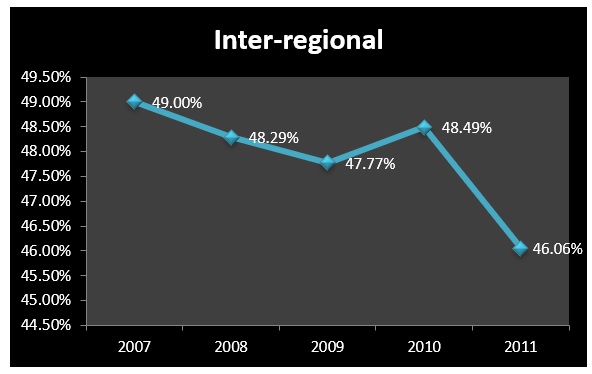
Graph 3: Pattern of Inter-Regional Inequality
Unlike interregional disparities, the graph below illustrates mostly upwards trend of intra-regional disparities with the highest value of 53.94% within region inequalities observed in 2011. On a comparative basis, intraregional inequalities are higher than the interregional inequalities. In contrast with the findings provided by Gezici and Hewings (2004), this research paper provides evidence for the growing patterns of intraregional inequalities relative to interregional inequalities.
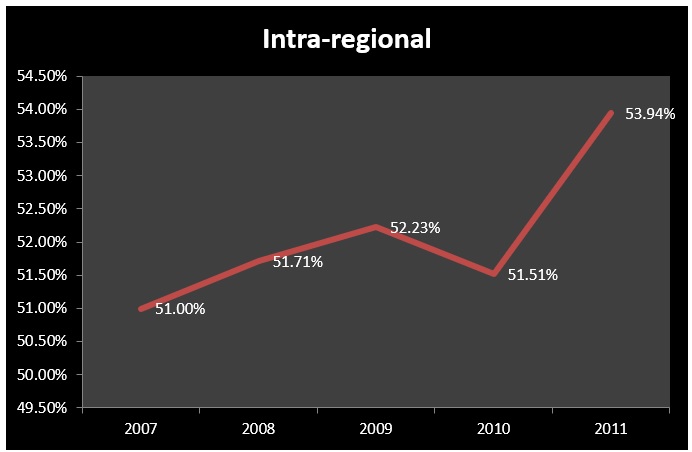
Graph 4: Pattern of Intra-Regional Inequality
Suggestions for Redistribution
During 2007-2011, the research results provide clear indication for the higher levels of intraregional inequalities, which has seriously implications for the policy implementation. Findings of the research recognize Marmara region as the dominant contributor to interregional and intraregional inequalities in Turkey. This may imply that the well developed regions of the country are making significant contributions to higher inequalities in the country. From a policy perspective, it is highly important to examine that whether this region has reached its maturity cycle of economic development or not because the marginal theories of economics indicate that as soon as an economy achieves its maximum growth potential; it moves downward with the gradually increasing income disparities (Chen and Zhou, 2005). This means that the gap between rich and poor is gradually becoming visible due to inappropriate distribution of income and other resources such as human capital with imbalanced opportunity creation for education and employment. On the other hand, analysis shows that the proportion of interregional inequalities is relatively low, and it has been declining in 2007-2009.
Yildirim (2004) stands to the view that government grant is one of the appropriate policy initiatives to equate and balance the performance of economic growth across provinces and regions. Keeping this into perspective, policy implications of the current research results pinpoint the need for redistributing national resources across the seven key regions so as to cope with the growing disparities within the regions.
Conclusion
In the light of above evaluations, Theil index provides clear indication for the increasing intraregional inequalities in Turkey while the pattern of interregional inequalities is declining. Interpretations of within and across region disparities on the basis of Theil index observations made during 2007-2011 are visibly different from those observed in the late 1990s. Findings of the research indicate Marmara and Central Anatolia regions as the key contributors to the growing disparities within and across regions in Turkey; in other words, the research results show that the poor regions relatively make little contribution to income inequalities than the developed ones. Nonetheless, the research infers that inequalities in turkey are rooted in within the region or intraregional inequalities. Therefore, the research identifies policy implications for considering the redistribution of national resources on the basis of inter and intraregional dependence among the seven regions of Turkey.
References
Balkir, C. (1995), “Less development regions and regional development policies in Turkey. European Urban and Regional Studies”, SAGE Publications, 2, 253–264.
Celebioglu, F. and Dall’erba, S. (2010), “Spatial disparities across the regions of Turkey: an exploratory spatial data analysis”, Ann Reg Sci, 45, 379–400.
Chen, Z. and Zhou, Y. (2005), Income Distribution During System Reform and Economic Development in China: The Status and Trend of Income Inequality of Chinese Residents. New York: Nova Publishers.
Gezici, F. and Hewings, J. D. G. (2004), “Spatial Analysis of Regional Inequalities in Turkey”, Proceedings of 43rd Congress of European Regional Science 27-30 August, 2003 Jyvaskyla, Finland, 2-27.
Gezici, F. and Hewings, J. D. G. (2007), “Spatial Analysis of Regional Inequalities in Turkey”, European Planning Studies, 15(3), 383-403.
Ostry, J. and Berg, A. (2014), “Redistribution, Income, and Growth”, International Monetary Fund.
Weede, E. (1997), “Income inequality, democracy and growth reconsidered”, European Journal of Political Economy, 13, 751-764.
Yildirim, J. (2004), “Regional Policy and Economic Convergence in Turkey: a Spatial Data Analysis”, Proceedings of the 18th European Advanced Studies Institute in Regional Science Conference, 1-13.


